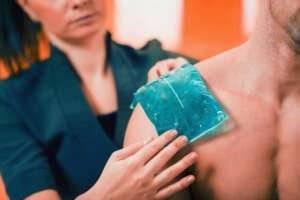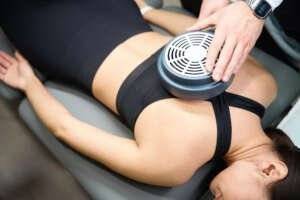
Understanding Shoulder Bursitis Shoulder bursitis is a condition that results from inflammation of the bursa, small fluid-filled sacs that reduce friction between bones, muscles, and tendons in the shoulder joint. This condition, often caused by repetitive motion, overuse, or injury, can lead to
- Pain and tenderness in the shoulder.
- Swelling and redness.
- Limited range of motion.
- Increased discomfort with activity or pressure.
Treatment usually involves rest, anti-inflammatory medications, physical therapy, and temperature therapy—an essential tool for non-invasive pain management.
Ice Therapy: Combating Inflammation in Shoulder Bursitis

Ice therapy is widely used to manage acute injuries by reducing inflammation and swelling. It works by constricting blood vessels, limiting blood flow to the area, and decreasing cellular activity.
When to Use Ice Therapy
- During the initial 48-72 hours of acute symptoms.
- When the shoulder feels warm, swollen, or red.
How to Apply Ice Therapy
- Prepare an Ice Pack: Use a commercially available ice pack, a bag of frozen peas, or a homemade option wrapped in a thin towel.
- Apply for 15-20 Minutes: Place the pack on the shoulder, ensuring there’s no direct skin contact to avoid frostbite.
- Repeat Every 2-3 Hours: Consistent application can keep inflammation under control.
- Monitor for Numbness: Remove the pack immediately if numbness occurs.
Scientific Evidence: Research published in the Journal of Athletic Training confirms the effectiveness of cryotherapy for reducing acute inflammation and pain in soft tissue injuries.
Heat Therapy: Promoting Recovery in Shoulder Bursitis

Heat therapy enhances blood flow to the affected area, reducing stiffness and encouraging muscle relaxation. It is particularly effective for chronic bursitis or when stiffness is the primary issue.
When to Use Heat Therapy
- For chronic bursitis symptoms beyond the inflammatory phase.
- To address stiffness and muscle tightness.
- Before physical activity to loosen the joint.
How to Apply Heat Therapy
- Choose a Heat Source: Options include heating pads, hot water bottles, or warm towels. Microwaveable gel packs are also suitable.
- Ensure Safe Temperatures: The heat should be warm, not hot enough to cause burns.
- Apply for 15-20 Minutes: Use heat therapy several times daily, especially before stretching or exercise.
Scientific Evidence: A study in the Journal of Physical Therapy Science highlights how heat therapy improves blood flow, reduces stiffness, and enhances mobility, making it ideal for the later recovery stages.
Heat vs. Ice: Choosing the Right Therapy
The best treatment depends on your condition’s stage and symptoms. Here’s a quick reference guide:
| Symptom/Stage | Ice Therapy | Heat Therapy |
|---|---|---|
| Acute inflammation | Best Choice | Avoid |
| Chronic pain or stiffness | Less effective | Best Choice |
| Post-exercise soreness | Effective | Avoid |
| Pre-exercise preparation | Less effective | Effective |
Contrast Therapy: A Combined Approach For maximum relief, consider alternating between ice and heat therapy:
- Start with 10 minutes of ice to reduce inflammation.
- Switch to 10 minutes of heat to improve circulation and relax muscles.
- Repeat the cycle for up to an hour, ensuring there’s no skin irritation.
Practical Tips for Effective Temperature Therapy
- Start Gradually: If unsure, begin with shorter application times and adjust based on comfort.
- Combine with Other Treatments: Use alongside rest, medication, and physical therapy for comprehensive care.
- Listen to Your Body: If symptoms worsen or persist, consult a healthcare professional.
Conclusion Heat and ice therapy are powerful, non-invasive tools for managing shoulder bursitis. While ice is crucial during the inflammatory phase, heat therapy shines during recovery and for addressing stiffness. By understanding when and how to use these methods effectively, you can take charge of your recovery, reduce discomfort, and regain mobility.
References
- Bleakley, C. M., & Costello, J. T. (2013). “Do thermal agents affect a range of movement and mechanical properties in soft tissues?” Journal of Athletic Training, 48(4), 436-443.
- Ariana, M., et al. (2022). “The Effect of Local Heat Therapy versus Cold Rub Gel on Pain and Joint Functions.” Clinical Nursing Research, 31(6), 1014-1022.
- Hubbard, T. J., & Denegar, C. R. (2004). “Does cryotherapy improve outcomes with soft tissue injury?” Journal of Athletic Training, 39(3), 278-279.


